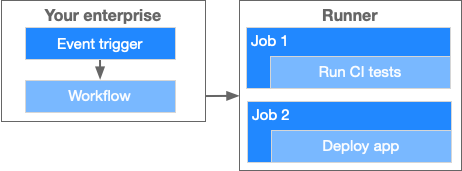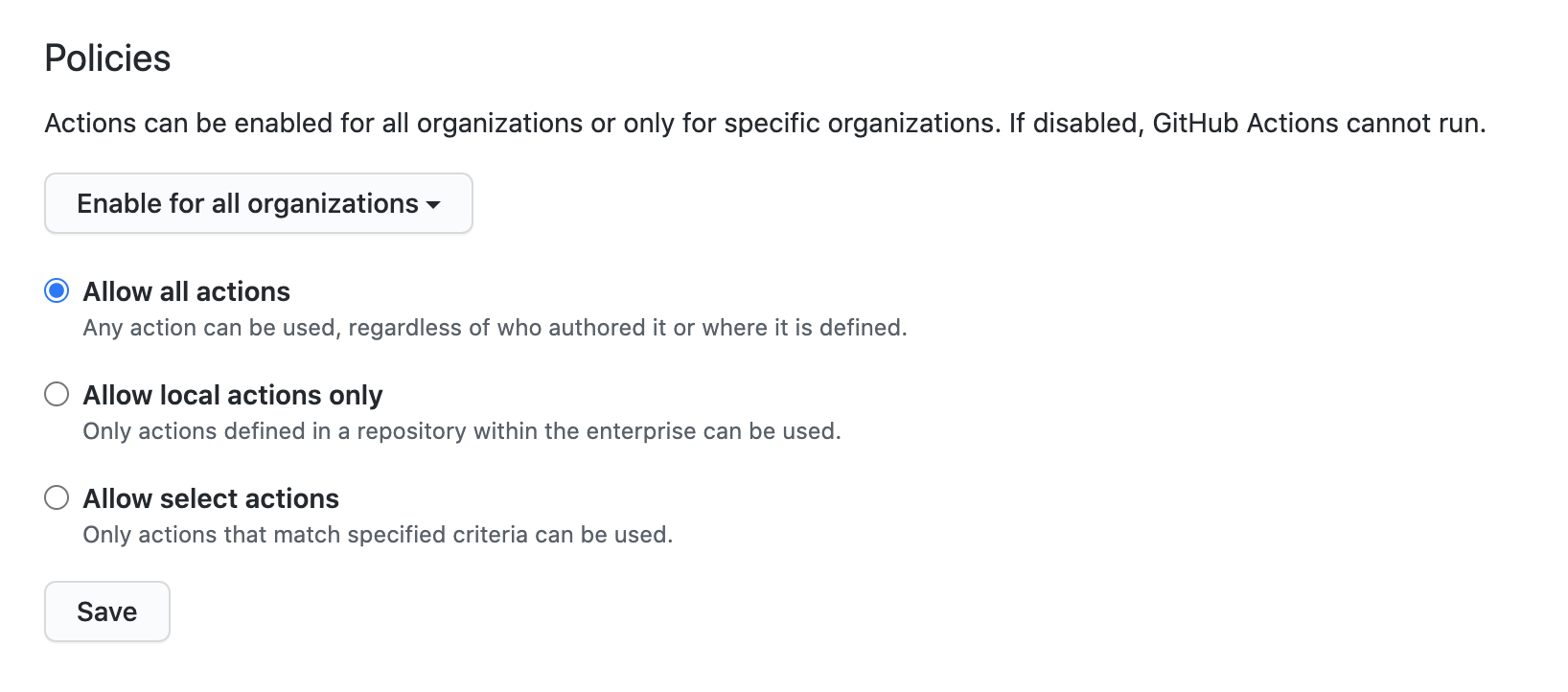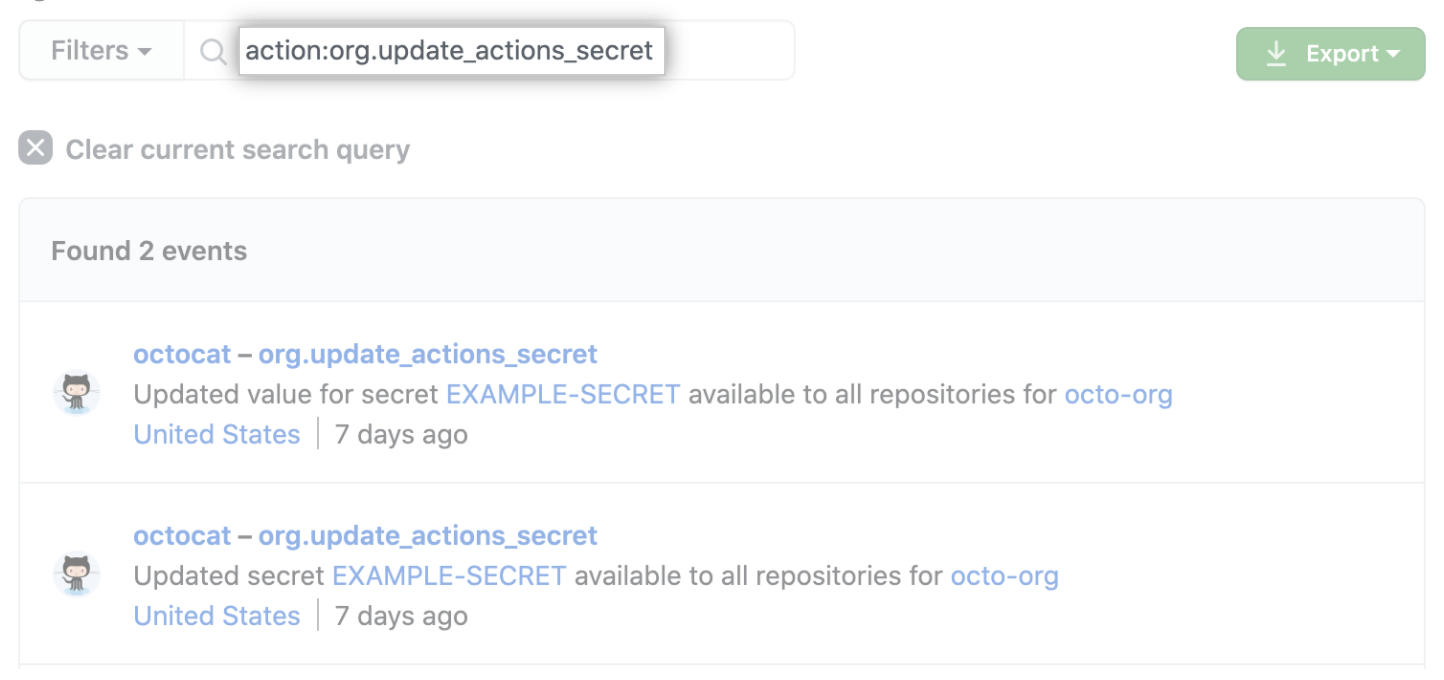About GitHub Actions for enterprises
GitHub Actions は、ビルド、テスト、デプロイのパイプラインを自動化できる継続的インテグレーションと継続的デリバリー (CI/CD) のプラットフォー� です。 With GitHub Actions, your enterprise can automate, customize, and execute your software development workflows like testing and deployments. For more information, see "About GitHub Actions for enterprises."

GitHub Actions は、GitHub Enterprise Server 3.0 以降で使用できます。 以前のバージョンの GitHub Enterprise Server を使用している� �合は、GitHub Actions を使用するようにアップグレードする必要があります。 GitHub Enterprise Server インスタンスのアップグレードの詳細については、「新しいリリースへのアップグレードについて」を参照してく� さい。
Before you introduce GitHub Actions to a large enterprise, you first need to plan your adoption and make decisions about how your enterprise will use GitHub Actions to best support your unique needs.
Governance and compliance
You should create a plan to govern your enterprise's use of GitHub Actions and meet your compliance obligations.
Determine which actions your developers will be allowed to use. First, decide whether you'll enable access to actions from outside your instance. Enterprise のユーザが GitHub.com または GitHub Marketplace からの他のアクションにアクセスする必要がある� �合、いくつかの設定オプションがあります。 For more information, see "About using actions in your enterprise."
Then, decide whether you'll allow third-party actions that were not created by GitHub. You can configure the actions that are allowed to run at the repository, organization, and enterprise levels and can choose to only allow actions that are created by GitHub. If you do allow third-party actions, you can limit allowed actions to those created by verified creators or a list of specific actions. For more information, see "Managing GitHub Actions settings for a repository", "Disabling or limiting GitHub Actions for your organization", and "Enforcing policies for GitHub Actions in your enterprise."

You can access information about activity related to GitHub Actions in the audit logs for your enterprise. If your business needs require retaining this information longer than audit log data is retained, plan how you'll export and store this data outside of GitHub. For more information, see "Log forwarding."

Security
You should plan your approach to security hardening for GitHub Actions.
Security hardening individual workflows and repositories
Make a plan to enforce good security practices for people using GitHub Actions features within your enterprise. For more information about these practices, see "Security hardening for GitHub Actions."
You can also encourage reuse of workflows that have already been evaluated for security. For more information, see "Innersourcing."
Securing access to secrets and deployment resources
You should plan where you'll store your secrets. We recommend storing secrets in GitHub, but you might choose to store secrets in a cloud provider.
In GitHub, you can store secrets at the repository or organization level. Secrets at the repository level can be limited to workflows in certain environments, such as production or testing. For more information, see "Encrypted secrets."
 You should consider adding manual approval protection for sensitive environments, so that workflows must be approved before getting access to the environments' secrets. For more information, see "Using environments for deployments."
You should consider adding manual approval protection for sensitive environments, so that workflows must be approved before getting access to the environments' secrets. For more information, see "Using environments for deployments."
Security considerations for third-party actions
There is significant risk in sourcing actions from third-party repositories on GitHub. If you do allow any third-party actions, you should create internal guidelines that encourage your team to follow best practices, such as pinning actions to the full commit SHA. For more information, see "Using third-party actions."
Innersourcing
Think about how your enterprise can use features of GitHub Actions to innersource automation. Innersourcing is a way to incorporate the benefits of open source methodologies into your internal software development cycle. For more information, see An introduction to innersource in GitHub Resources.
To provide a starting place for developers building new workflows, you can use starter workflows. This not only saves time for your developers, but promotes consistency and best practice across your enterprise. For more information, see "Creating starter workflows for your organization."
Whenever your workflow developers want to use an action that's stored in a private repository, they must configure the workflow to clone the repository first. To reduce the number of repositories that must be cloned, consider grouping commonly used actions in a single repository. For more information, see "About custom actions."
Managing resources
You should plan for how you'll manage the resources required to use GitHub Actions.
Hardware requirements
You may need to upgrade the CPU and memory resources for your GitHub Enterprise Server instance to handle the load from GitHub Actions without causing performance loss. For more information, see "Getting started with GitHub Actions for GitHub Enterprise Server."
Runners
GitHub Actions workflows require runners. You will need to host your own runners by installing the GitHub Actions self-hosted runner application on your own machines. For more information, see "About self-hosted runners."
Decide whether you want to use physical machines, virtual machines, or containers for your self-hosted runners. Physical machines will retain remnants of previous jobs, and so will virtual machines unless you use a fresh image for each job or clean up the machines after each job run. If you choose containers, you should be aware that the runner auto-updating will shut down the container, which can cause workflows to fail. You should come up with a solution for this by preventing auto-updates or skipping the command to kill the container.
You also have to decide where to add each runner. You can add a self-hosted runner to an individual repository, or you can make the runner available to an entire organization or your entire enterprise. Adding runners at the organization or enterprise levels allows sharing of runners, which might reduce the size of your runner infrastructure. You can use policies to limit access to self-hosted runners at the organization and enterprise levels by assigning groups of runners to specific repositories or organizations. For more information, see "Adding self-hosted runners" and "Managing access to self-hosted runners using groups."
Finally, you should consider security hardening for self-hosted runners. For more information, see "Security hardening for GitHub Actions."
Storage
成果物を使うと、ワークフロー内のジョブ間でデータを共有し、ワークフローが完了したときに、そのワークフローのデータを保存できるようになります。 For more information, see "Storing workflow data as artifacts."
You must configure external blob storage for workflow artifacts and other workflow logs. Decide which supported storage provider your enterprise will use. For more information, see "Getting started with GitHub Actions for GitHub Enterprise Server."
You can use policy settings for GitHub Actions to customize the storage of workflow artifacts and log retention. For more information, see "Enforcing policies for GitHub Actions in your enterprise."
Tracking usage
You should consider making a plan to track your enterprise's usage of GitHub Actions, such as how often workflows are running, how many of those runs are passing and failing, and which repositories are using which workflows.
You can use webhooks to subscribe to information about workflow jobs and workflow runs. For more information, see "About webhooks."
Make a plan for how your enterprise can pass the information from these webhooks into a data archiving system. You can consider using "CEDAR.GitHub.Collector", an open source tool that collects and processes webhook data from GitHub. For more information, see the Microsoft/CEDAR.GitHub.Collector repository.
You should also plan how you'll enable your teams to get the data they need from your archiving system.